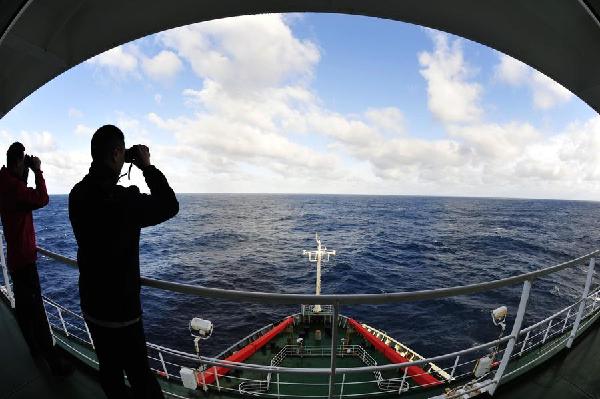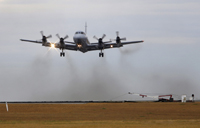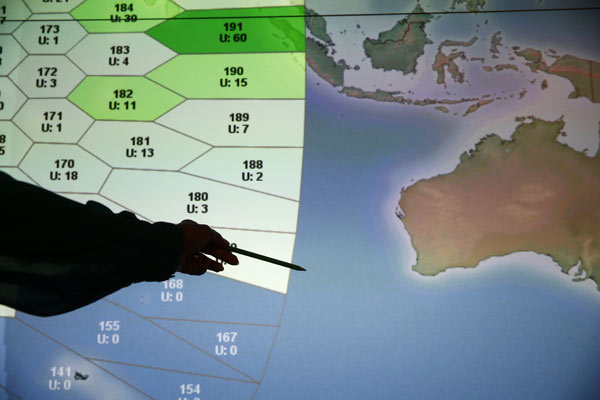
| Latest News | Search effort | Families' reaction | Timeline | Reporter's log |
| Infographic | Doubts | Airlines' statement | Photos | China's perspective |
 |
| Chinese icebreaker Xuelong presses ahead in the area where Chinese airborne searchers spotted some suspicious objects, March 26, 2014. [Photo/Xinhua] |
|
 |
|
 |
A Xinhua correspondent aboard the plane said the meteorologic conditions were complicated.
Meanwhile, multinational search for the wreckage of the missing jetliner has resumed off Western Australia's coast following the improvement in weather conditions, local media reported on Wednesday.
Conditions around the search area are expected to favor the search on Wednesday, said Adam Conroy, senior weather forecaster from the Australian Bureau of Meteorology.
"Weather conditions are set to improve through the search area in the southern Indian Ocean. [We] should see winds and seas ease and really just isolated showers through the area," Conroy told the Australian Broadcasting Corporation (ABC).
Twelve planes and several ships are expected to join the search and recovery operation, with six countries involved in the search - Australia, New Zealand, the United States, Japan, China and the Republic of Korea, according to the ABC.
China has not suspended its search operation in other possible search areas despite Malaysian Prime Minister Najib Razak's announcement on the ill-fated plane.
Chinese icebreaker Xuelong arrived in the area where Chinese airborne searchers spotted some suspicious objects on Monday.
Late Monday, Najib said the missing plane "ended" in the southern Indian Ocean, based on new calculations by Inmarsat, a British satellite company that provided the satellite data.
Chinese naval vessels continued to scour waters southwest of Sumatra on Tuesday.
"We should not be distracted by the uncertain information from outside," said Liu Zhonghu, captain of the Jinggangshan amphibious docking vessel.
Liu said the Jinggangshan and another vessel, the Yongxingdao, would continue to do their utmost to comb the target sea area in accordance with previously agreed international search arrangements.
In Washington, the state department said Tuesday that the United States was approaching Inmarsat for satellite data to conduct its own analysis in order to corroborate the company's conclusion.
Spokeswoman Marie Harf, who said a day earlier the US had no "independent corroboration" about the crash of Flight MH370 as announced by Malaysian Prime Minister Najib Razak based on an analysis of satellite data by the Inmarsat company, told reporters that Washington was "in touch" with the two sides.
"We are in touch with both the Malaysian government about their calculations and the British company about their images to see if we can independently confirm their data analysis through our own data analysis," Harf said at a regular news briefing.
No trace of the missing plane has been found since the two vessels entered their assigned search areas near Sumatra early Saturday, an area of some 53,000 square nautical miles (181,785 square km) between Nias Island and Christmas Island.
Another Chinese naval fleet consisting of supply ship Qiandaohu, missile destroyer Haikou and amphibious transport dock Kunlunshan was expected to arrive in the waters southwest of the Australian port of Perth on Wednesday.
Flight MH370, a Boeing 777-200, went missing on its way to Beijing on March 8, shortly after take-off from Kuala Lumpur, the Malaysian capital. The plane was carrying 12 crew and 227 passengers, including 154 Chinese.
The multi-national massive search for the missing jetliner has entered the third week.
|
 |
| A member of staff at satellite communications company Inmarsat poses in front of a section of the screen showing the southern Indian Ocean to the west of Australia, at their headquarters in London March 25, 2014. [Photo/Agencies] |








